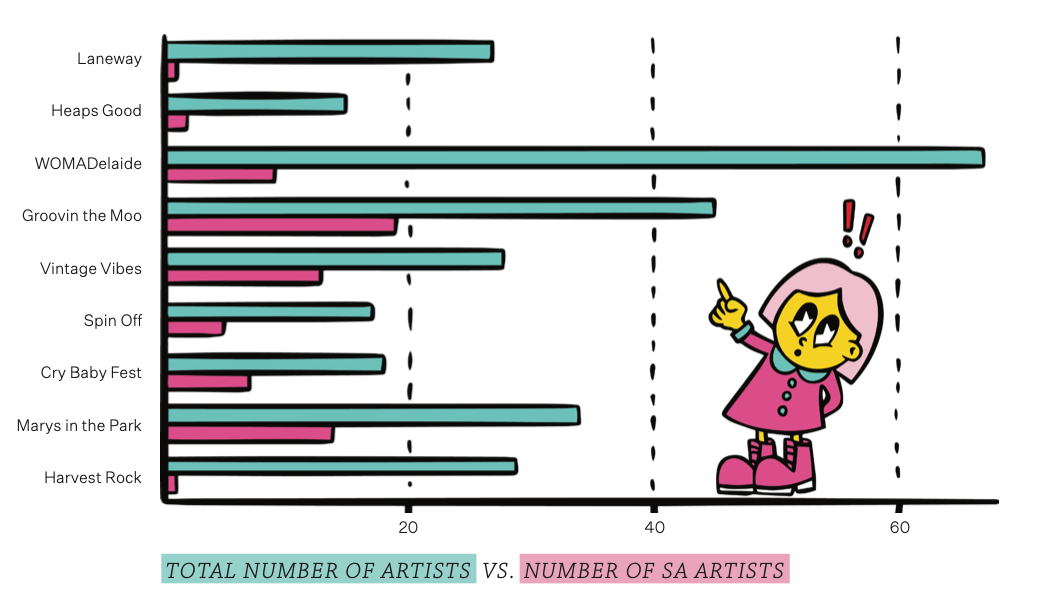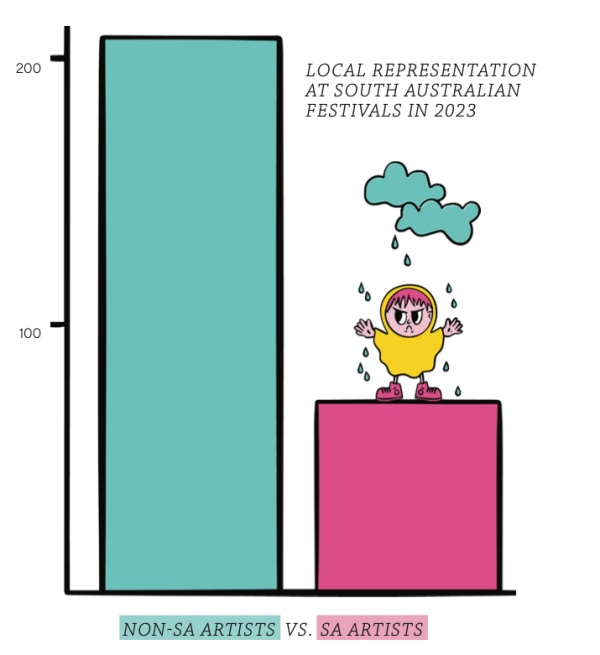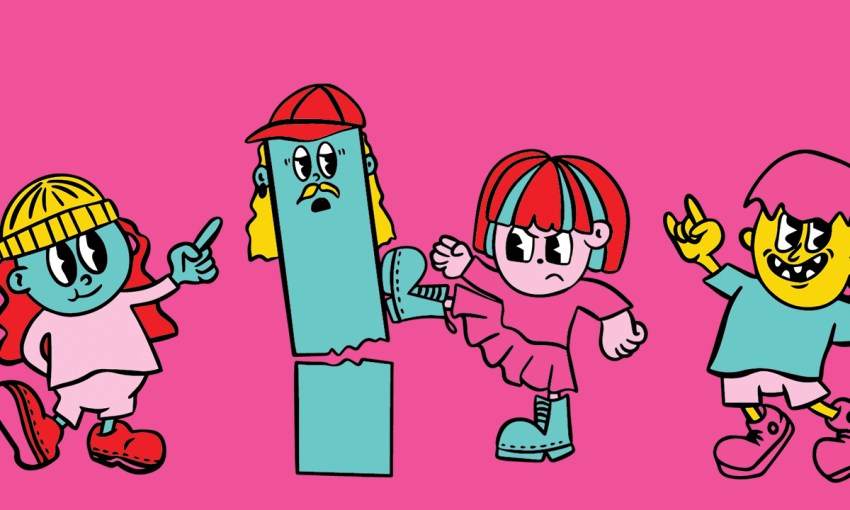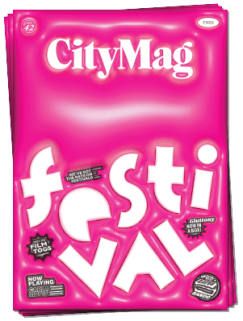In a moment when the city’s live music venues are closing for good, festivals are becoming the new way many are exposed to SA talent. Reporters David Simmons and Helen Karakulak dig deep into the numbers and ask: do we need a locals quota?
Festivals by the numbers
Harvest Rock has, in just two years, become a hotly anticipated festival for South Australians and interstate visitors. Boasting world-class musicians, some of whom play exclusively at Harvest Rock and nowhere else in the country, the two-day romp in the eastern parklands is polished, pristine, friendly and fun.
But last year, just one band on the lineup was local: Bad//Dreems.
For CityMag, and the local artists that read our mag, there was a glaring lack of local on the 2023 bill – made even more disappointing considering the event is taxpayer-funded via a partnership with the South Australian Tourism Commission (SATC).
It got us thinking: is this issue pervasive or is Harvest Rock an outlier?
So we crunched the numbers.

Nine festivals were dissected: Laneway, Heaps Good, WOMADelaide, Groovin the Moo, Vintage Vibes, Spin Off, Cry Baby Fest, Marys in the Park and Harvest Rock. Most of these are mainstream, but we threw Cry Baby Fest and Marys in the Park into the mix to see how niche festival lineups stacked up.
It was a time-consuming but largely simple process to determine how many artists on each lineup were based and working in Adelaide. This meant artists like Paul Kelly – though originally from SA – were considered Victorian.
On average, 25 per cent of all acts booked across major SA festivals in 2023 were local acts. Most lineups did well, with Laneway and Harvest Rock the only culprits with just one Adelaide act.

The average was skewed by standout Groovin the Moo, which had close to half its lineup being local thanks in part to a unique program called Fresh Produce which promotes local artists at each stop of the national touring festival and gives them a stage of their own to strut their stuff. Unfortunately, Groovin’ the Moo announced last month it won’t be going ahead this year due to a lack of ticket sales.
Vintage Vibes also pushed the average up. The inaugural event prioritised local talent, with 46.4 per cent of the lineup being South Australian. But it could be a while until we see that local love again given Vintage Vibes’ 2024 edition has been postponed due to economic uncertainty.
CityMag sat down with Music SA CEO Christine Schloithe to comb through the stats and she says the data “bodes well for the South Australian music industry”.

“We’re definitely seeing a higher proportion of South Australian acts having a rightful place on these festival lineups,” she says.
“There’s always going to be room to do better, and I understand in terms of some of these festivals and how they program and what their business makeup is why some of the choices were made, but some of these findings are obviously disappointing in terms of the lower ratio.”
So how should festivals like Harvest Rock – a state government-backed major festival and a tourism drawcard – and Laneway – which derives its single local act each year from a Triple J-run competition – improve their local representation on lineups?
CityMag suggested to Christine that a “locals quota” could be one way forward.
“I think quotas are a good idea but they’re very difficult to enforce, particularly when you’re dealing with festivals that rely on minimal government subsidies, and they’re entitled to make whatever decision that they need to,” she says.
“I think the way to approach that is for South Australian industry to be more vocal and more present, and to really work more collaboratively with the national industry to make sure that key decision makers are aware of how big the talent pool is here in South Australia.”
She adds that festivals, like our live music venues, are dealing with “unprecedented pressures from a lot of different angles”.
“Festivals need the ability to make financially robust decisions and sometimes that means local artists can skew the financial viability of a festival because they don’t bring in the same numbers of paying punters as some of the larger, more well-known acts,” Christine says.

Another solution was put to the Music SA CEO: could a condition of receiving funding be ensuring a percentage of lineups was local?
“It certainly can be a condition of a grant, but again it comes down to the purpose that funding is being given in the first place,” she says.
“Harvest Rock for example, that money is on the table because the festival is about increasing visitation to South Australia. It’s not a grant that supports the artistic development of a live music festival, and those are two fundamentally different things.
“There is a level of frustration that we don’t have government departments working more cohesively because I think it’s a pretty easy solution to just include a couple of metrics inside tourism funding that actually supports the cultural capacity of artists in this state.”
Are you a local artist? Let’s get to know each other.
Join our Artist Network, and let us know about your new releases.
SATC told CityMag it supports a lineup that encourages visitors to South Australia. Curating the Harvest Rock artist and food and beverage lineup is the role of the organiser, Secret Sounds.
“[Secret Sounds] takes into consideration a range of factors including audience feedback, appeal to visitors, talent budget, diversity, and artist availability,” an SATC spokesperson says.
“At both the 2022 and 2023 events, all suppliers and vendors, including the entire food and beverage lineup, were from South Australia, an outcome Secret Sounds remains committed to.
“In each of the two years of Harvest Rock, at least 30 per cent of attendees were from out-of-state, with hotel room occupancy in greater metropolitan Adelaide at record levels.”

Secret Sounds did not provide a comment regarding Harvest Rock, or Spin Off and Heaps Good – events they also organise – by the time of publication.
Vintage Vibes says showcasing local acts is an ongoing conversation they have within their organisation.
“It reflects our commitment to nurturing local talent and providing them with a platform to shine,” says the representative.
“We wholeheartedly support the notion of a locals quota initiative. Elevating local acts to major festival stages like Vintage Vibes is more than just good practice – it’s essential for the growth and sustainability of the music industry here in South Australia.

“Such an initiative would ensure that local artists are given the exposure they deserve, helping to foster a vibrant cultural ecosystem that benefits artists, festival-goers, and the community at large.”
At WOMADelaide, 13.4 per cent of artists were South Australian; a reasonable feat for a festival that could have an easy out since their ethos is to present music, arts and dance from around the world.
Associate director Annette Tripodi told CityMag that since the debut WOMAD in 1992, its track record for platforming First Nations and Adelaide-based artists has been strong.
Since 2020, WOMAD has supported the development of local artists through its collaboration with the City of Playford’s Northern Sound System, dubbed the NSS Academy.
The Academy focusses on professional development for young and emerging First Nations and culturally diverse artists who are guided by industry professionals. Selected artists from the academy get the opportunity to perform at WOMAD.
“We believe that, particularly for emerging artists, or those who don’t get mainstream airplay, there is no better way to provide exposure than by putting them alongside the more established international artists and delivering them a large, generous audience,” Annette says.
“While we would hope that locals are not forgotten by other major festivals when they are making programming decisions, we wouldn’t support a quota rule.
“Programming is already quite a complex beast and, ultimately, WOMAD wants to present a high-quality program that is completely different from the previous year, with a good balance of genres and sounds and a combination of artists who are well-known and those who are ‘discoveries’.”
Let’s go, girls!

As we dove deep into lineups, we also looked at gender representation within the same festivals. We excluded Marys in the Park due to it being an outlier and inherently diverse in gender expression as an LGBTQIA+ festival with drag performers. We also excluded WOMAD from the data at this stage, as defining the gender of multiple performers within art collectives requires more resources and, frankly, our fragile Excel spreadsheet couldn’t handle it.
The results were promising, finding all but one festival in our sample had more than 50 per cent representation of non-male performers – that is performers that are female, fem-presenting, non-binary or gender diverse.
Across all the 2023 festivals we observed, the average percentage of non-male performers was 53 per cent.
The highest performer in gender representation was Spin Off, with 70.5 per cent of their performers being non-male.
The lowest performer in gender representation was Vintage Vibes, with only 28.5 per cent of their performers being non-male.
A representative from Vintage Vibes says they actively consider gender representation in their lineup “to ensure a balanced and varied festival experience”.
“While we don’t have a rigid quota system, we strive to create a lineup that is reflective of the rich tapestry of talent across genders,” they say.
GROOVIN’ THE MOO WAS FOR LOCALS

After this story was published in our print mag, Groovin’ the Moo announced it was cancelled for 2024.
Groovin the Moo was our highest scorer at platforming locals last year – which is why it’s a shame the national program was axed.
Its Fresh Produce program filled a stage of locals in each state the festival stops at – which, excluding Adelaide, is all regional.
The local stage programmer, Claire Qian, tells CityMag being a regional and all-ages festival, Groovin connects with local promoters.

Claire was dismayed at being told of the multiple live venue closures in Adelaide’s west end at the end of 2023.
“Experience performing in local venues is super important for emerging artists,” she says.
“The more practice you get performing in front of a crowd prepares you for bigger shows in the future. Meeting other people in the scene and asking certain artists to be your support… that entire experience helps an artist broaden their network and broaden their skills.
“Seeing those little local bands is really what builds that momentum to one day see your favourite band at a festival.”
Which is why CityMag urges all punters to go out and support local.





